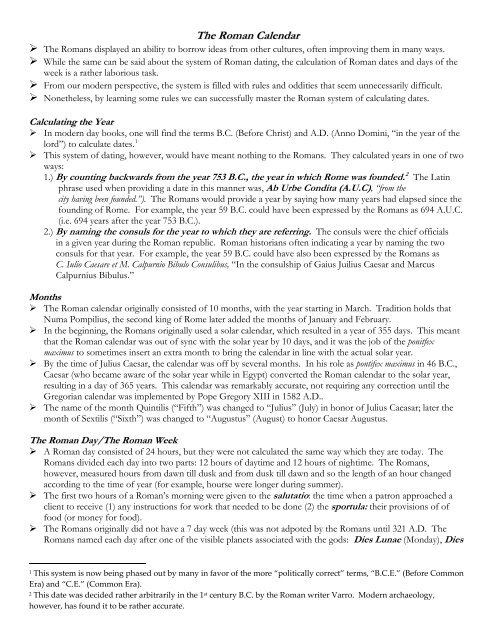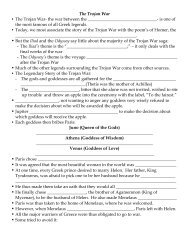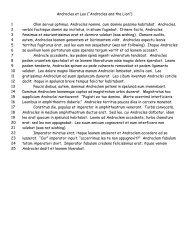The Roman Calendar Reading - Medina City Schools
The Roman Calendar Reading - Medina City Schools
The Roman Calendar Reading - Medina City Schools
Create successful ePaper yourself
Turn your PDF publications into a flip-book with our unique Google optimized e-Paper software.
TThhee RRoommaann CCaalleennddaarr<br />
<strong>The</strong> <strong>Roman</strong>s displayed an ability to borrow ideas from other cultures, often improving them in many ways.<br />
While the same can be said about the system of <strong>Roman</strong> dating, the calculation of <strong>Roman</strong> dates and days of the<br />
week is a rather laborious task.<br />
From our modern perspective, the system is filled with rules and oddities that seem unnecessarily difficult.<br />
Nonetheless, by learning some rules we can successfully master the <strong>Roman</strong> system of calculating dates.<br />
CCaallccuullaattiinngg tthhee YYeeaarr<br />
In modern day books, one will find the terms B.C. (Before Christ) and A.D. (Anno Domini, “in the year of the<br />
lord”) to calculate dates. 1<br />
This system of dating, however, would have meant nothing to the <strong>Roman</strong>s. <strong>The</strong>y calculated years in one of two<br />
ways:<br />
1.) By counting backwards from the year 753 B.C., the year in which Rome was founded. 2 <strong>The</strong> Latin<br />
phrase used when providing a date in this manner was, Ab Urbe Condita (A.U.C), “from the<br />
city having been founded.”). <strong>The</strong> <strong>Roman</strong>s would provide a year by saying how many years had elapsed since the<br />
founding of Rome. For example, the year 59 B.C. could have been expressed by the <strong>Roman</strong>s as 694 A.U.C.<br />
(i.e. 694 years after the year 753 B.C.).<br />
2.) By naming the consuls for the year to which they are referring. <strong>The</strong> consuls were the chief officials<br />
in a given year during the <strong>Roman</strong> republic. <strong>Roman</strong> historians often indicating a year by naming the two<br />
consuls for that year. For example, the year 59 B.C. could have also been expressed by the <strong>Roman</strong>s as<br />
C. Iulio Caesare et M. Calpurnio Bibulo Consulibus, “In the consulship of Gaius Juilius Caesar and Marcus<br />
Calpurnius Bibulus.”<br />
MMoonntthhss<br />
<strong>The</strong> <strong>Roman</strong> calendar originally consisted of 10 months, with the year starting in March. Tradition holds that<br />
Numa Pompilius, the second king of Rome later added the months of January and February.<br />
In the beginning, the <strong>Roman</strong>s originally used a solar calendar, which resulted in a year of 355 days. This meant<br />
that the <strong>Roman</strong> calendar was out of sync with the solar year by 10 days, and it was the job of the ponitfex<br />
maximus to sometimes insert an extra month to bring the calendar in line with the actual solar year.<br />
By the time of Julius Caesar, the calendar was off by several months. In his role as pontifex maximus in 46 B.C.,<br />
Caesar (who became aware of the solar year while in Egypt) converted the <strong>Roman</strong> calendar to the solar year,<br />
resulting in a day of 365 years. This calendar was remarkably accurate, not requiring any correction until the<br />
Gregorian calendar was implemented by Pope Gregory XIII in 1582 A.D..<br />
<strong>The</strong> name of the month Quintilis (“Fifth”) was changed to “Julius” (July) in honor of Julius Caeasar; later the<br />
month of Sextilis (“Sixth”) was changed to “Augustus” (August) to honor Caesar Augustus.<br />
TThhee RRoommaann DDaayy//TThhee RRoommaann WWeeeekk<br />
A <strong>Roman</strong> day consisted of 24 hours, but they were not calculated the same way which they are today. <strong>The</strong><br />
<strong>Roman</strong>s divided each day into two parts: 12 hours of daytime and 12 hours of nightime. <strong>The</strong> <strong>Roman</strong>s,<br />
however, measured hours from dawn till dusk and from dusk till dawn and so the length of an hour changed<br />
according to the time of year (for example, hourse were longer during summer).<br />
<strong>The</strong> first two hours of a <strong>Roman</strong>’s morning were given to the salutatio: the time when a patron approached a<br />
client to receive (1) any instructions for work that needed to be done (2) the sportula: their provisions of of<br />
<br />
food (or money for food).<br />
<strong>The</strong> <strong>Roman</strong>s originally did not have a 7 day week (this was not adpoted by the <strong>Roman</strong>s until 321 A.D. <strong>The</strong><br />
<strong>Roman</strong>s named each day after one of the visible planets associated with the gods: Dies Lunae (Monday), Dies<br />
1 This system is now being phased out by many in favor of the more “politically correct” terms, “B.C.E.” (Before Common<br />
Era) and “C.E.” (Common Era).<br />
2 This date was decided rather arbitrarily in the 1st century B.C. by the <strong>Roman</strong> writer Varro. Modern archaeology,<br />
however, has found it to be rather accurate.
Martis (Tuesday), Dies Mercurius (Wednesday), Dies Iovis (Thursday), Dies Veneris (Friday), Dies Saturni<br />
(Saturday), and Dies Solis (Sunday).<br />
<strong>The</strong> <strong>Roman</strong> calendar, however, was divided into eight day periods known as nundina. Every eighth day of the<br />
<strong>Roman</strong> calendar was known as a nundinae (market day) and the period in between was known as a nundinum.<br />
Each day of a nundial cycle was marked on a calendar with A-H (called nundial letters).<br />
In addition to containing the nundial letters, <strong>Roman</strong> calendars also contained letter indicating the type of<br />
public business that could be conducted on a certain day. <strong>The</strong>se types of days included:<br />
• Dies Fasti: “Sacred Days;” Lawsuits could be undertaken on these days.<br />
• Dies Comitales: Days on which <strong>Roman</strong> assemblies could meet (they could not meet if this fell on the<br />
nundinae or on certain feast days).<br />
• Dies Nefasti: “Unholy Days”; the oppostie of dies fasti and comitales; lawsuits could not be undertaken<br />
and assemblies could not meet.<br />
• Dies Endotercissi: Days that were nefasti in the morning and evening; but fasti the rest of the time.<br />
• Dies Religiosi: “Days of Ill Omen;” public business could not be taken up on these unless it absolutely<br />
had to be.<br />
• Dies Atri: “Black Days;” nothing could be done on these days; not even festivals.<br />
• Dies Festi: Days on which festivals were held.<br />
CCaallccuullaattiinngg DDaayyss ooff tthhee MMoonntthh<br />
<strong>The</strong> <strong>Roman</strong>s had a rather laborious way of calculating days of the month. <strong>The</strong>y had a series of “anchor dates”<br />
from which they counted backwards to calculate the day to which they were referring.<br />
One other oddity has to with how the <strong>Roman</strong>s counted when calculating a date: when the <strong>Roman</strong>s counted<br />
backwards, they counted inclusively: This means they counted the current day as day number one. For<br />
example, while we may consider “three days before Friday” to be Tuesday; the <strong>Roman</strong>s would have considered<br />
“three days before Friday” to be Wednesday (Friday day #1, Thursday day #2, and Wednesday day #3).<br />
<strong>The</strong> three key “anchor dates” for the <strong>Roman</strong>s were as follows:<br />
- <strong>The</strong> Kalends (“Kal”): This Refers to the 1 st day of a month.<br />
- <strong>The</strong> Ides (“Id.”): This refers to the middle day of a month; it fell on the 15 th in March, May, July, and August; in all other<br />
months it fell on the 13 th .<br />
- <strong>The</strong> Nones (“Non”): This term means “ninths;” it refers to nine days before the Ides; therefore it fell on the 7 th in March,<br />
May, July, and August; in all other months it fell on the 5 th .<br />
To indicate time before a certain date, the <strong>Roman</strong>s used one of two phrases:<br />
- pridie: this was only used to indicate the day before a certain day<br />
- ante diem (a.d.): “the day before;” it is paired up with <strong>Roman</strong> numerals to indicate how many days before.<br />
Examples of <strong>Roman</strong> dates for January: (Ides on the 13 th ; Nones on the 5 th ):<br />
January 1 st : Kal. Ian. (<strong>The</strong> Kalends of January)<br />
January 3rd: a.d. III Non. Ian. (3 days before the Nones of January)<br />
Jaunary 5 th : Non. Ian. (<strong>The</strong> Nones of January)<br />
January 8 th : a.d. VI Id. Ian. (6 days before the Ides of January)<br />
January 13 th : Id. Ian. (<strong>The</strong> ides of January)<br />
January 20 th : a.d. XIII Kal. Feb. (13 days before the Kalends of February)<br />
January 31 st : pridie Kal. Feb. (the day before the Kalends of February)<br />
Example of <strong>Roman</strong> dates for March (Ides on the 15 th ; Nones on the 7 th ):<br />
March 1 st : Kal. Mart. (<strong>The</strong> Kalends of February)<br />
March 3 rd : a.d. V Non. Mar. (5 days before the Nones of March)<br />
March 7 th : Non. Mart. (<strong>The</strong> Nones of March)<br />
March 8 th : a.d. VIII Id. Mart. (8 days before the Ides of March)<br />
March 15 th : Id. Mart. (the Ides of March)<br />
March 20 th : a.d. XIII Kal. Apr. (13 days before the Kalends of April)<br />
March 31 st : pridie Kal. Apr. (the day before the Kalends of April)














